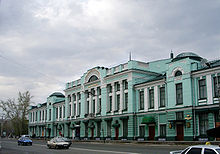Проект Никилева Александра:
Omsk is a city
and the administrative center of Omsk Oblast, Russia, located in southwestern
Siberia 2,236 kilometers from Moscow. With a population of over 1.1 million, it
is Russia's second-largest city east of the Ural Mountains after Novosibirsk,
and seventh by size nationally

Omsk
Omsk is the
administrative center of the Siberian Cossack Host. It also serves as the see
of the bishop of Omsk and Tara, as well as the administrative seat of the Imam
of Siberia.
Omsk stretches
along on the banks of the north-flowing Irtysh at its confluence with the
smaller Om River. The city has an elevation of 87 meters above mean sea level
at its highest point.
The
architectural centerpiece of the city is an ensemble of buildings along
Lyubinsky Avenue/Lenina Street, anchored by the former Gostiny Dvor, and
flanked by two chapels. The area is an eclectic mix of architectural styles,
dominated by Art-Nouveau, Neoclassical and Second Empire. The Drama Theater
gives a good example of the latter. Soviet Era additions run the gamut from
Constructivist to Stalinist to Brutalist.
Closer to the
confluence of the Om and the Irtysh are the few surviving sombre buildings of
the 18th-century fortress. The largest and most opulent church in the city is
the Dormition Cathedral, a five-domed edifice in the Russian Revival style,
consecrated in 1896, demolished by the Soviets, and restored in the early first
decade of the 21st century.
As a prominent
educational center, Omsk has a large number of museums, theaters, music venues,
and educational institutions.
Among Omsk's
museums, the most notable are:
The State Museum
of Regional History
The Dostoyevsky
Museum of Literature
The Vrubel
Museum of Fine Arts
The Military
Museum Complex
The Kondraty
Belov Art Museum
The Liberov Center for Art
Theaters include
the Omsk Opera, The Omsk Theater of Drama, The Omsk Circus, and a number of
smaller venues.
Omsk is a major
rail, road, and air hub. The city is served by a station on the Trans-Siberian
Railroad, and by the Tsentralny Airport. Additionally, Omsk possesses a river
port on the Irtysh, offering service to domestic destinations and to cities
within Kazakhstan.
Municipal
Transport consists of a large bus and trolley, and tram networks, although the
latter of these has deteriorated severely since the collapse of the USSR.
Marshrutkas supplement municipal transit networks.
Omsk is home to
many institutions of higher learning and several universities:
ANO - Institute
of Economics and Energetics
AKSI, Aksyonov
Institute of Law and Economics, West Siberian department
Law and
Economics Institut
Omsk Academy of
Law
Omsk Academy of
MVD Rossija
Omsk Aviation
Technical School
Omsk Foreign
Language Institute
Omsk Medical
Academy
Omsk State
Transport University (1961)
Omsk State
Agrarian University (1918) (connected with Omsk State Veterinary Institute and
Institute of Agribusiness and Continuing Education)
Omsk State
Pedagogical University
Omsk State
University (1974)
Omsk Institute
of Consumer Service Technology
Omsk State
Technical University (1942)
SibADI -
Siberian State Automobile and Highway Academy
SibGUFK -
Siberian Academy of Physical Culture
Siberian
Institute of Business and Information Technology
Sovremennyi Gomunitarnyi University
SIBNFOR - Siberian Stock Market Institute

Vocabulary
Located- расположен
Size- размер
Bishop – епископ
Stretches – тянется
Banks – банки
Confluence – слияния
Elevation – высота
Centerpiece – гуляш
Ensemble – ансамбль
Anchored – якорь
Former – бывший
Flanked – окруженный
Dominated – доминируют
Additions – дополнения
Gamut – гамма
Opulent – роскошная
Edifice – здание
Consecrated – освящен
Demolished – снесена
Restored – восстановлены
Decade
– десятилетие
Prominent
– известный
Venues – объекты
Notable – заметный
Possesses – обладает
Offering – предлагая
Domestic – внутренний
Severely – серьезно
Supplement – Возможно











Комментариев нет:
Отправить комментарий